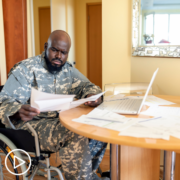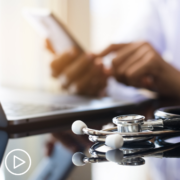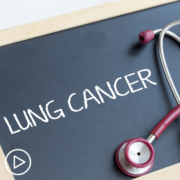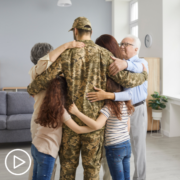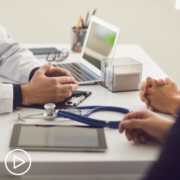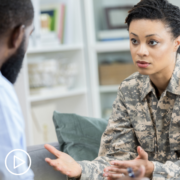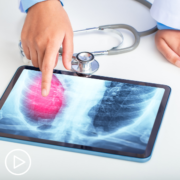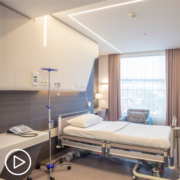Can Veterans in Rural Areas Facing Lung Cancer Access Experts Via Telemedicine?
Can Veterans in Rural Areas Facing Lung Cancer Access Experts Via Telemedicine? from Patient Empowerment Network on Vimeo.
Are there telemedicine options for veterans living in rural areas? Expert Dr. Michael Kelley from Duke University School of Medicine discusses the rural residence rate of veterans, consultation services, and second opinions.
[ACT]IVATION TIP
“And you can actually get a second opinion where you have a video visit with the expert as well. So these things are all available. So patients can ask for these for a second opinion. And there’s somebody else in the VA who would be an expert that we would connect the patient with.”
Download Resource Guide | Descargar guía de recursos
See More from [ACT]IVATED NSCLC Veterans
Related Resources:
Transcript:
Lisa Hatfield:
I live in a more rural area of the country, if you have a patient who lives in a more rural area or maybe goes to a smaller VA facility for healthcare and they’re diagnosed with non-small cell lung cancer, can they access maybe through telemedicine visits, somebody who is more specialized in that type of cancer within the VA system, or how is that handled for veterans?
Dr. Michael Kelley:
Yes. So about a third of enrolled veterans live in rural areas. So this is very common for us. That’s 33 percent and the nation is about 14 percent. So it’s about two-and-a-half times likely that a veteran will be in a rural area. So VA has very mature advanced telehealth capabilities. We have tele ICU. We have tele emergency room services. And we have teleoncology. So there’s a national teleoncology service. It basically provides an expert in your cancer type at your VA. And this is mostly serving rural veterans.
I think the last number I saw was 44 percent of the veterans that are served by the national teleoncology service are in rural areas. So I practice in South Dakota and Arkansas, and I live in North Carolina. And I do only lung cancer. So this is a service that I think my colleagues also participate in around the country. And we’re able to get the expertise to the patient rather than the patient coming to the expertise.
Lisa Hatfield::
That’s very helpful for patients. I know I have a different type of cancer, a blood cancer, but being able to access at least the expertise of a specialist makes a big difference in my care. And, of course, my local oncologists are great, but they’re willing to work with my specialists. So I appreciate that the VA has such a brilliant advanced system for that. That’s a really impressive statistic that many patients, veterans use that telehealth option.
Dr. Michael Kelley:
Yeah, so in addition to the direct care, we also provide consultation services. So you mentioned that your local provider is willing to work with an expert. So we do that as well. So we can have what are called e-consults, electronic consults, where the local oncologist who might be a generalist is able to ask a question to an expert.
And because we are such a large system, we have an expert in everything. And I literally mean everything. So we have an expert lined up to be able to respond to every question and from any disease that is in the realm of oncology or hematology.
Lisa Hatfield:
Okay. And will that typically happen during a visit, or is it up to the patient to request that e-consult if they would like one?
Dr. Michael Kelley:
So it’s typically up to the provider, if they think they need a second opinion or they need help interpreting this, interpreting an opinion. But the patient can always ask as, you know, that you can ask their provider, talk to their provider, which I understand from a patient’s perspective can be sort of a sensitive issue is, “Hey, I don’t trust you. You’re my doctor, but I don’t trust you. Can you ask someone else for an opinion?” But you can do it in a way which is very respectful, obviously, and it’s totally okay with us, that, I’m always happy to ask a colleague to look at a case if a patient asks.
And you can actually get a second opinion where you have a video visit with the expert as well. So these things are all available. So patients can ask for these for a second opinion. And there’s somebody else in the VA who would be an expert that we would connect the patient with.
Lisa Hatfield:
Thank you for reassuring patients that it’s okay to do that. I know sometimes we’re afraid of offending our providers, but as you said, it’s okay to politely say, “This is very scary for me. I would like to know if there’s any way to do an e-consult with another physician. So yeah, thank you for reassuring patients that that’s okay to do that.
Dr. Michael Kelley:
Yeah. There should be nothing that any patient ever asks or brings up with us that is offensive to us. Your concern is our concern. So don’t be afraid to ask for it. My biggest concern is that you won’t let me know when you have a concern.
Share Your Feedback
Create your own user feedback survey

